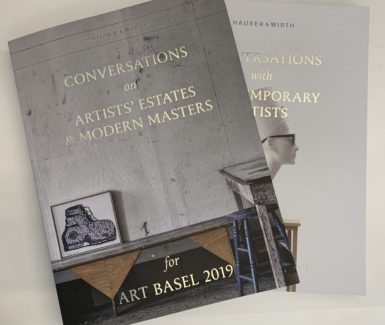[ad_1]

Basel, Switzerland.
COURTESY SHUTTERSTOCK
This morning, rumors that have been circulating around the art world about Gagosian doing an off-site exhibition during Art Basel devoted to postwar abstraction were confirmed in an announcement from the gallery. The show opens a new front in the ongoing battle for primacy in Basel, where dealers fight for market share—not just with each other, but with the auction houses.
Gagosian has staged offsite shows of mostly contemporary art during Miami Basel since 2015, collaborating with Jeffrey Deitch. But doing so during Basel, the mother of all art fairs, which opens next week, is new territory. Unlike the Miami exhibitions, which take place far from the fair, in the Design District, the new Swiss outing is located within eyesight of the ultra-luxe Trois Rois hotel, where many prominent dealers and collectors stay. The price points also appear to be suitably higher in Switzerland, with works by historical heavyweights like Pollock, de Kooning, and Frankenthaler in the mix.
The Basel battle extends into virtual space. Last year, Gagosian launched a special online viewing room timed to the fair (and in March, it sold a $6 million Albert Oehlen in another that coincided with Basel Hong Kong). This year, Zwirner, which tapped Artsy’s Elena Soboleva last August to develop its online sales platform, is doing the same.
Publications have also become a weapon. It is not unusual for mega-galleries to produce a publication for their fair presentations, but this year Hauser & Wirth has taken things to a whole new level, printing not one but two books that together total 450 glossy pages. One is devoted to contemporary artists, the other to estates and historical art. (It may seem excessive to create a hefty tome for a four-day event, but the auction houses regularly do the same for events that essentially last only a couple hours, and these volumes will no doubt sit on coffee tables for years to come.)
All of this raises concerns about how much galleries are now expected to pay to do an art fair. While budgets have long run into the hundreds of thousands of dollars—including booth fees—the biggest galleries now spend into the millions. (Start tabulating the cost of shipping, travel, accommodations, and entertaining in Switzerland, and your head begins to spin.)

Hauser & Wirth’s publications.
PHOTO: ARTNEWS
So how do loss-leaders, like catalogues, with all the time and manpower that goes into them, pay off? As one dealer put it to me, there are two approaches to running a successful gallery: (1) You cultivate a dedicated group of collectors, and/or (2) You cultivate relationships with esteemed (pricy) artists so that they are willing to produce work for you regularly. Context helps cultivate those relationships, and glossy catalogues not only make dealers look friendly, approachable, informed, and interested/interesting—it keeps some artists happy, by putting them in a compelling context.
A case study of what is on offer: In one of its catalogues, titled “Conversations on Artists’ Estates & Modern Masters,” Hauser & Wirth has included a short essay by Jack Whitten’s widow, Mary Whitten, about his final painting, which was dedicated to Arshile Gorky, just ahead of a long section dealing with work it is bringing to Basel by Arshile Gorky. (Hauser represents both Whitten’s estate and Gorky’s foundation. Making the display even more timely: many collectors no doubt saw the big Gorky show in Venice that was presented at Ca’ Pesaro in cooperation with the foundation.)
The very fact that Hauser’s catalogues are called “Conversations” is important: What is an art fair if not a chance to have conversations that—either on the spot or over the course of months—turn into a sale? Or lead to an ongoing conversation and many, many sales?
In a recent turn of events that, to this editor’s mind, should not go unremarked-upon, Artnet News earlier this week republished an excerpt from Hauser’s “Conversations with Contemporary Artists,” an interview Randy Kennedy did with Jenny Holzer. Kennedy is ex-New York Times journalist, and Jenny Holzer is certainly a newsworthy artist, and the fact that the interview appears in Hauser’s catalogue is noted on Artnet, but the republishing of what is essentially marketing material on a purported news site strikes me as slightly fishy; I certainly hope Artnet got paid for running this content.
The big question now is: How do smaller, single-venue galleries compete in this climate? As it happens, this edition of Art Basel marks the introduction of its new slide-scale booth-pricing system, which requires about one-third of galleries to pay larger fees so that the remaining two-thirds can pay a bit less. It remains to be seen whether such initiatives effectively preserve the current art gallery ecosystem or if we are in for a sea change.
[ad_2]
Source link

